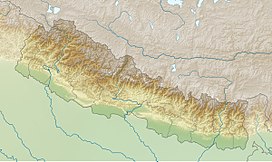Dhaulagiri
| Dhaulagiri | |
|---|---|
 |
|
| Highest point | |
| Elevation | 8,167 m (26,795 ft) Ranked 7th |
| Prominence | 3,357 m (11,014 ft) Ranked 55th |
| Isolation | 318 kilometres (198 mi) |
| Parent peak | K2 |
| Listing |
Eight-thousander Ultra |
| Coordinates | 28°41′54″N 83°29′15″E / 28.69833°N 83.48750°ECoordinates: 28°41′54″N 83°29′15″E / 28.69833°N 83.48750°E |
| Geography | |
| Parent range | Dhaulagiri Himal |
| Climbing | |
| First ascent | May 13, 1960 by Kurt Diemberger, A. Schelbert, E. Forrer, Nawang Dorje, Nyima Dorje (First winter ascent 21 January 1985 Jerzy Kukuczka and Andrzej Czok) |
| Easiest route | Northeast ridge |
The Dhaulagiri massif in Nepal extends 120 km (70 mi) from the Kaligandaki River west to the Bheri. This massif is bounded on the north and southwest by tributaries of the Bheri River and on the southeast by Myagdi Khola. Dhaulagiri I is the seventh highest mountain in the world at 8,167 metres (26,795 ft) above sea level. It was first climbed on May 13, 1960 by a Swiss/Austrian/Nepali expedition.
The mountain's name is धौलागिरी (dhaulāgirī) in Nepali. This comes from Sanskrit where धवल (dhawala) means dazzling, white, beautiful and गिरि (giri) means mountain. Dhaulagiri I is also the highest point of the Gandaki river basin.
Annapurna I (8,091m/26,545 ft) is 34 km. east of Dhaulagiri I. The Kali Gandaki River flows between the two in the Kaligandaki Gorge, said to be the world's deepest. The town of Pokhara is south of the Annapurnas, an important regional center and the gateway for climbers and trekkers visiting both ranges as well as a tourist destination in its own right.
Looking north from the plains of India, most 8,000-metre peaks are obscured by nearer mountains, but in clear weather Dhaulagiri I is conspicuous from northern Bihar and as far south as Gorakhpur in Uttar Pradesh. In 1808 A.D. survey computations showed it to be the highest mountain yet surveyed. This lasted until 1838 when Kangchenjunga took its place, followed by Mount Everest in 1858.
...
Wikipedia

